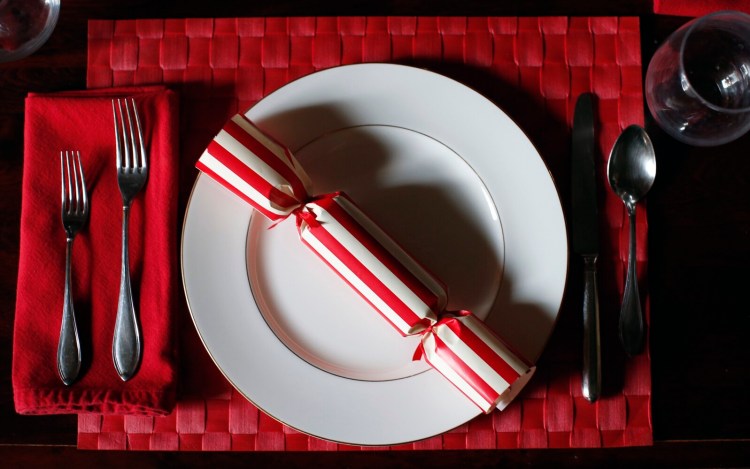This will unlikely come as a surprise, but I found a fallacy on Facebook recently. In early October, two posts claimed that Christmas crackers opened in the United Kingdom this holiday season would result in 154,000,000 pieces of plastic being dumped in the ocean.
Christmas crackers, party favors set at each place around a holiday table, were new to me when I married into my husband’s British-American family 25 years ago. They resemble large candy twists but are really just wrapped and decorated cardboard tubes, each filled with a paper crown (tissue party hat), a motto (joke or riddle), a snap (friction-activated popping device), and a small gift or novelty item.
Crackers are usually shared between two individuals, often with their arms crossed, one pulling on each end. With the ends firmly gripped, the pair slowly pulls the crackers apart, an action that tears them open, activates the snap to produce a small bang, and frees the contents of the tube. Revelers don the hats, tell the corny jokes and marvel at the novelties inside.
While the quality of the gifts varies according to how much you pay for them – you can drop $10,000 for a cracker that holds a 20-diamond Cartier necklace – most of the time you get a tiny deck of cards, a bottle opener, a kazoo, or a plastic puzzle of some sort. I’ve cleaned up from enough Christmas dinners to know that many of those small plastic items are indeed discarded by their intended recipients. I have a collection in the drawer of my dining room sideboard.

Dress your holiday table with DIY holiday crackers. Ben McCanna/Staff Photographer
But the internet fact-checking outfit, truthorfiction.com, could find no hard facts to substantiate these Facebook Christmas cracker boycotter’s claims. The 154 million number seems to have been extrapolated from a 2017 British Airways survey of just 2000 Brits who were asked how many crackers they would likely pull that year. While plausible, there is no direct proof that all the plastic novelties pulled from these or any crackers will be tossed into the sea. But that doesn’t discount the likelihood that some amount – either lesser or higher – will be, so the point of the boycott is not lost on me.
In fact, I’ve swapped my typical $60 online order for Olde English Crackers for a $6 order for simply the snaps. I’ve saved toilet paper rolls for the last two months in order to assemble my own crackers this year with the help of an online tutorial from an Olde English employee who walks viewers through the process. Mine won’t have plastic toys in them, but they will carry multiple sustainability messages inside.
I’ll wrap toilet paper tubes in paper and ribbon saved from last year’s holidays in order to reinforce the refuse, reduce, reuse and recycle mantra. The bad jokes will still be conveyed, but those bits of recycled paper they’re written on will also only include a fact or two about climate change chaos so we can talk about both how dire the situation is and the bold solutions necessary to combat a warming world.
I’ll stuff my DIY crackers with home-made treats like Goat Milk Vanilla Caramels with Maine Sea Salt to highlight how cooking with local ingredients and eating fewer factory farmed animal products reduces our personal carbon footprints. And the gifts that fall out of the tubes will be reusable straws, cloth produce bags and beeswax cloth sheets so that the revelers who enjoy the excitement of the celebratory bang of the Christmas cracker have the means to whittle down their consumption of single-use plastics all year long.
CHRISTINE BURNS RUDALEVIGE is a food writer, recipe developer and tester, and cooking teacher in Brunswick, and the author of “Green Plate Special,” a cookbook from Islandport based on these columns. She can be contacted at cburns1227@gmail.com.

Goat’s milk caramels with Maine sea salt. Ben McCanna/Staff Photographer
Goat Milk Caramels with Maine Sea Salt
Makes 60 caramels
½ cup butter, cut into pieces, plus extra butter to coat baking dish
1 cup brown sugar
1/2 cup granulated sugar
1/4 cup honey
1 1/4 cups goat’s milk
1 1/2 cups heavy cream
1 1/2 tablespoons vanilla extract
Maine sea salt
Coat a 9- X 9-inch pan with butter and set aside.
Combine the butter, sugars, honey, goat milk, and heavy cream in a 6-quart pot and place over high heat. Cover the pot and cook for 3 minutes. Lift the lid and stir the now boiling contents to make sure the sugar is melted. Attach a candy thermometer to the side of the pot so that is it submerged in the boiling syrup.
Reduce the heat to medium. Cook, stirring frequently, until the caramel reaches 248 degrees F, about 45 minutes. Remove the pot from the heat. Stir in the vanilla extract. Pour the caramel into the buttered baking dish. Sprinkle salt lightly over the caramel. Cool for at least 3 hours. Cut into 60 pieces and wrap caramels in waxed paper.
Comments are not available on this story.
Send questions/comments to the editors.


